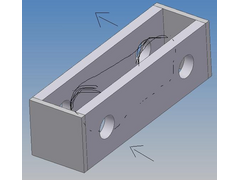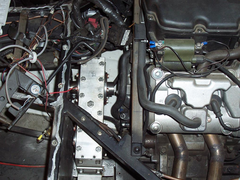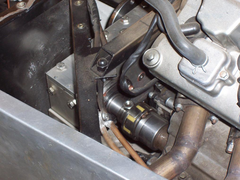
Building a transmission
tks - 18/4/06 at 02:09 PM
In order to make my prop angle a bit better and tune up the rear wheel bhp´s a bit i´m thinking of making a transmission.
I have got the materials and the desing skills only i wanted some opinions and i wanted to know if there is bearing specialist on the forum..
because i have no idea wich type to choose.
i was thinkinh between the normal one or the tappered ones.. anyone??
Rpm will be 7800rpm max (red top of 13.000) sow anyone on this one?
as transmission in the box i wanted to use chain and sprockets will it work?
The box will be made out of 20mm and 10mm aluminium.
the bearing will be milled in and the axles will be made with the lathe...
its not that my current setup don´t works its just the nast feeling that it could fail that keeps me worying, also i think the resistance is allot
lower doing it with an extra box..(sow in fuel it will refund)


Rescued attachment Idea.JPG
flak monkey - 18/4/06 at 02:59 PM
I work for a bearings company in the summer, but they dont do stuff suited for what you want. Same principals apply, so here goes...
Normal sealed ball bearings will be fine in your application (you will just need to check the RPM limit). You only need to use taper bearings where
there is any thrust present, in a chain drive there isnt any. (Assuming there is none present on either the output or input sfat either - normal
bearings will take a reasonable axial load, but nothing too high, or shock loadings).
You should use standard open cage ball bearings and lip seals really. But it depends what you have available to you.
Once you have made your shafts you need to have the bearing surfaces ground to the exact size specified in the bearing specifications. Yes, they
*must* be ground.
Remember you must provide axial location for the bearings and shafts, and relive the shoulder which the bearing sits against on the shaft.
Make the housing a press in fit for the bearings, either on size (and use an assembly adhesive/bearing retainer adhesive) or make it 0.01mm smaller
than the OD of the bearing and push it in with a 5ton press. Press only on the outer race, otherwise you will destroy the bearing (you will need to
make a press tool for this job).
I have an SKF bearing datasheet if you need it. But its too big to attach here.
David
[Edited on 18/4/06 by flak monkey]
wildchild - 18/4/06 at 03:20 PM
quote:
Originally posted by flak monkey
Yes, they *must* be ground.
Disagree.
Picking up a random bearing catalogue (NSK), it demands Ra 0.8 finish for 'small bearings' (looser for bigger bearings).
You could turn that on a decent lathe if you did it carefully. I'd be more worried about boring the housing out accurately than the shaft.
I'd also go for using one radial ball bearing and one roller bearing on each shaft. You don't need two ball bearings (as you rightly say,
there's negligible axial thrust).
MikeRJ - 18/4/06 at 03:26 PM
quote:
Originally posted by tks
In order to make my prop angle a bit better and tune up the rear wheel bhp´s
Note that you can only trade off torque for RPM, you cannot increase rear wheel power using a gearbox. In fact rear wheel power will be slightly
reduced due to the extra transmission losses (though chain and sprockets are very efficient).
flak monkey - 18/4/06 at 03:28 PM
Yes i should have said that the housing needs to be through bored in one operation. Not a simple task, depending on the width of it.
You will also have fun getting the 2 bearing surfaces dead concentric and parallel as they ideally need machining in one setup, if not, they need to
be turned and ground between centres.
And i would like to see you get a 0.8micronRa surface finish on a lathe  . Its right on the limit of the process capability.
. Its right on the limit of the process capability.
trikerneil - 18/4/06 at 08:09 PM
Have a look HERE and go 3/4 of the way down the page for my take on the problem and some
info.
wildchild - 19/4/06 at 07:48 AM
quote:
Originally posted by flak monkey
Yes i should have said that the housing needs to be through bored in one operation. Not a simple task, depending on the width of it.
You will also have fun getting the 2 bearing surfaces dead concentric and parallel as they ideally need machining in one setup, if not, they need to
be turned and ground between centres.
And i would like to see you get a 0.8micronRa surface finish on a lathe  . Its right on the limit of the process capability.
. Its right on the limit of the process capability.
I know it's on the limit, but it's not impossible (ought to be a fairly short shaft) and it's a much lesser problem than the
housing.
Obviously grinding it would be better 
tks - 19/4/06 at 12:53 PM
Ok, then i change the setup a bit,
In order to archieve the lateral parts to the same geometrie, i will let the holes water cut @ the diamter of the bearing - 0,01 will the faceing be
fine enough???
laser wont be at that thickness (20mm)
My first idea was to make every fitting a heatup process (in the end its all alloy)
and 0,01 will be easy to archive while heating it up? another problem i just realise is that maybe the hole sheet will deform because of heating.. sow
maybe the press is better.
anyway, the water machine will make the hole for me,
with a lathe then i will made a part sow i can make the bearing stop but still giveing the axle 1mm room to be bigger.
That part will be made 2 times blind and 2 times with the room for the sealing spring ring (don't know the UK name  ).
).
the other trick will be that i need to build it up nicely sow to archive that i will make 2 holes more per side, and i will put a ally tube in
that.
than i have the lateral parts almost square on waterjet/cut tolerantions.
i was thinking of a axle dimension of 35mm but have no idea if its to much or to less 
 , just on feeling..
, just on feeling..
i don't see any need to use needle rollers because i think it will complicate the desing very very much and the torque won't be very much
that saying maybe the 35mm is also to much...
@David:
Would like to see the sheet to be able to finish the designing stage of the box and to start working with some real dimensions.
have you got any link?
@Neil: cant find nothing on your site and the liks doesn't work sow please clearafy a bit..
thanxs any one for your help sofar!
If it works like always the complete project incl. drawing will come on the net
p.s. i do disagree about less BHP at the rear wheels, because i now use a prop UJ setup and the angle it has is impressive! maybe it are 20degrees!!
(look at my archive) i needed to take away some feet room from the passenger side (LHD car)..
(the middle bearing is situated near the end of the seat..)
to be able to get to the engine!
i'm sure it is more resistance then when making this box, i agree on the part that using chain i archieve a high eff.
it will cost a bit it the chain part, but i will reserve allot in the near 0 degrees prop alingment..!!
also the car works fine have to admit that i never have putted it in 6 on the ground and going at top speed..(more revs)
but in first and second it works, no vibrations, no noise...
Regards,
Tks
Schrodinger - 19/4/06 at 01:00 PM
One thing that's not obvious from your plan so far is how are you going to maintain the chain tension. ISTR that normally with chain driven cars
the distance betweent the shafts is adjustable in order gain the correct tension and change the chain.
flak monkey - 19/4/06 at 01:02 PM
Let me know your email address and i will email you the data sheet.
I am not sure on the surface finish capability of water jet cutting. I wasnt sure that it has enough accuracy and repeatability to get you 0.01mm
interference fit.
With regards the axial alignment of the shaft holes, they need to be perfect otherwise the sahfts will bind. This means they need to be reamed or
bored to size after the housing has been made, not before!
You will have trouble pressing the bearings into the completed housing so I wouls suggest you bore the holes out to onsize and use bearing retainer
adhesive (available through Loctite) to hold the bearings in (it is very good stuff, and designed for the job!).
Why do you need to allow for 1mm expansion? The transmission will not get that hot. 0.25mm endfloat on each shaft will be enough. Just be careful how
you machine the shafts, as the bearing surfaces on each end need to be *perfectly* concentric and parallel.
David
NS Dev - 19/4/06 at 01:39 PM
Been reading this with interest as I will be doing something similar in the not too distant future.
All the accuracy stuff is getting ott.
You can use semi-self aligning bearings and avoid the need for mega accurate centres.
On a 6 wheel drive offroader that we built we made a chain drive drop box to drop the drive between the two rear driving axles. We used a piece of
steel RHS (6" by 3" by 3/16" or 1/4"iirc) with end caps weled each end and welded bosses each side, plopped em through with a
vertical mill and pcd drilled them for end covers. We used taper roller bearings both ends installed against steps on the inside of each boss, with a
stepped shaft one end and a threaded locking collar the other, to stop the shaft walking.
we used morse (gear) chain from a rangerover transfer box iirc (poss two rangerover chains joined and then adjusted for length, can't remember
now) and did not use a tensioner, think we just used the slack from the taper bearings when the adjuster collar was backed right off to get the shafts
through the chainwheels, then the chain tensioned up when the bearings were adjusted up, though don't quote me on that, it was 10 years ago now!
wildchild - 19/4/06 at 02:08 PM
I was about to suggest self aligning bearings!
As a further thought how about using 'plummer block' type bearing housings and mounting them to a suitably rigid frame. You'd then
just have to add a very lightweight surround to catch the oil spray, rather than building a full structural casing.
Your frame could even incorporate some adjustment for chain tension.
Anyone got any experience of using these types of housing? I imagine if specced properly they would be up to the job, and you'd only have to
worry about machining the shaft to a good enough finish.
NS Dev - 19/4/06 at 03:28 PM
yep, lots of grassers use that setup, come up to Shepshed to see the racing on sunday and you can see plenty of open chain driven twin bike engine
cars!
tks - 13/7/06 at 07:29 PM
Everything is done
this afternoon my mum gets me the complete thing from the lathe man.
i don't have a chain tensioner yet because he could fit the chain without one.
We will see how well it works.
like every system we have transmission losses in the form of torque.
If you use a angle what i had.. i'm sure you loose there torque.. 30degrees? 25??
Sow i'm sure i win bhp rear wheel power now.
will post some pics when i have it.
the bike gearbox has also ball bearing and roller bearing.
but in this case i just went for 4 ballbearings.
the shaft are left a bit longer so i can mount a electric reverse motor. when needed.
wich oil should i use? normal diff oil??
how much should i topup the box??
i thought that if i touch the sprocket with 10mm it should be enough??
is it true that the chain would spetter enough to grease all the bearings??
or should i do them manually??
i have changed the with of the box to 70mm only!! the axles are very very stiff, the sprockets are 9mm with..
the chain is 5/8.
how i have got a good solution.
anyway it doesn't matter if i should change a bearing every 5000km
They are only 4pounds!! (SKF 6008)
Tks
tks - 31/10/06 at 08:49 AM
Didn´t finished this topic yet
but i have uploaded some pics!!


Mounted
and this is the coupling used how much miles would it last??


Coupling (would it work??)
Any comments?
Tks
NS Dev - 31/10/06 at 09:35 AM
Have you used a single 5/8" chain?
That would be my only worry, but I am no expert.
On the drive we built (for much more torque though) we used borg warner silent gear chain from a range rover transfer box, which is about 50mm wide
from memory.
Oil wise, yes the chain should splash lube the bearings, but for a start I would be tempted to run the box with the oil deep enough to just get onto
the bearings anyway.
No idea what oil you *should* use, we used EP90 diff oil
tks - 31/10/06 at 09:44 AM
I use a 5/8 inch chain with 9mm with sprockets.. that chain should be able to widstand some huge KG´s. i guess 2500Kgs
The case is filled on the upper side (centre nut) with the level being beyond the sidewards nut.
we shall see,
in fact i like what you say, because you cant see any problem in the coupling.....right??
TKs
NS Dev - 31/10/06 at 09:46 AM
no no, unless sombody else says otherwise, we've used those couplers on all sorts of industrial machines and they last for ages on them as long
as the shafts are in line. The nylon slippers in them are cheap anyway so not bad to change every so often
tks - 31/10/06 at 08:47 PM
Ok sounds promising then..
9mm pinion with that would be enough right??
Tks
NS Dev - 1/11/06 at 12:46 PM
Only one way to find out!!!! 
Doesn't sound strong enough to me but I am an agricultural engineer by qualification!

 . Its right on the limit of the process capability.
. Its right on the limit of the process capability. ).
). 